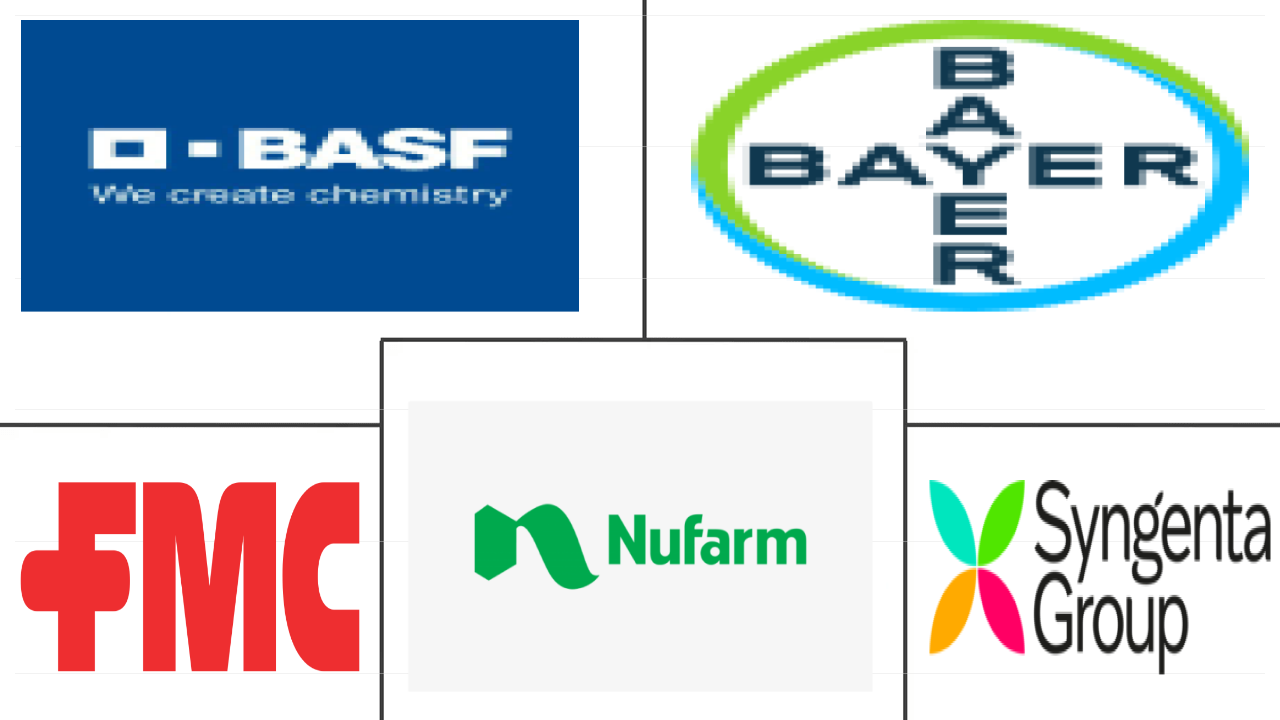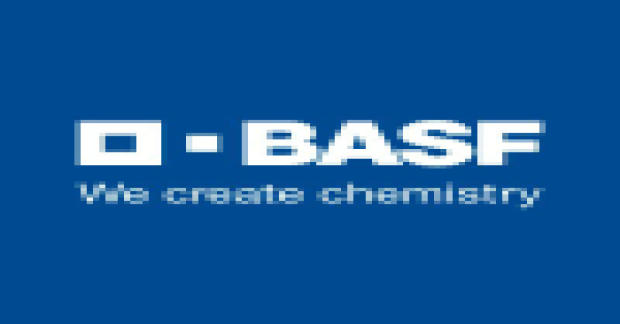Market Size of africa insecticide Industry
|
|
Study Period | 2017 - 2029 |
|
|
Market Size (2024) | USD 1.59 Billion |
|
|
Market Size (2029) | USD 1.91 Billion |
|
|
Largest Share by Application Mode | Foliar |
|
|
CAGR (2024 - 2029) | 3.76 % |
|
|
Largest Share by Country | South Africa |
|
|
Market Concentration | Low |
Major Players |
||

|
||
|
*Disclaimer: Major Players sorted in no particular order |
Africa Insecticide Market Analysis
The Africa Insecticide Market size is estimated at 1.59 billion USD in 2024, and is expected to reach 1.91 billion USD by 2029, growing at a CAGR of 3.76% during the forecast period (2024-2029).
1.59 Billion
Market Size in 2024 (USD)
1.91 Billion
Market Size in 2029 (USD)
4.50 %
CAGR (2017-2023)
3.76 %
CAGR (2024-2029)
Largest Segment by Application Mode
57.95 %
value share, Foliar, 2023
Insecticides like clothianidin, imidacloprid, and thiamethoxam are commonly used insecticides applied through the foliar method to control armyworms, stem borers, and sucking pests.
Largest Segment by Crop Type
46.47 %
value share, Grains & Cereals, 2023
Stem borers constitute the most widely distributed and injurious group of pests in terms of cereal crops. They are one of the major limiting factors of cereal production.
Largest Segment By Country
31.96 %
value share, South Africa, 2023
South Africa has a market-oriented agricultural economy that is highly diverse and includes major grains, oilseeds, deciduous and subtropical fruits, and vegetables.
Leading Market Player 1
5.95 %
market share, BASF SE, 2022

Inscalis insecticide and Broflanilide are two pioneering and highly effective insecticide active ingredients that strengthen BASF's insect-control offerings.
Leading Market Player 2
5.85 %
market share, FMC Corporation, 2022

FMC Corporation is focused on developing new ingredients and solutions to expand market access to new crops and geographies and address new challenges with insects.
The foliar method of application dominates the market due to its quick action
- Insecticides are applied through multiple methods in Africa, including chemigation, foliar application, seed treatment, soil treatment, and fumigation. These methods of pesticide application are contributing to the overall expansion of the market.
- The foliar method of application dominated the market in 2022, accounting for a share of 57.9%. The foliar application of insecticides is often a component of IPM strategies, allowing for targeted and precise application to manage pests while minimizing environmental impact. Insecticides like clothianidin, dinotefuran, imidacloprid, and thiamethoxam are the most commonly used systemic insecticides applied through the foliar method.
- Following the foliar application, seed treatment accounted for 16.8% of the African insecticide market in 2022. Soil-borne insects like the banana weevil Cosmopolites sordidus Germar, the sweet potato weevil Cylas formicarius Fabricius, the bean maggots Ophiomyia spencerella Greathead, O. phaseoli Tryon, and O. centrosematis de Meij are frequently reported as common agricultural pests impacting economic crops in countries across East Africa (Rwanda, Kenya, Tanzania, Uganda, and Burundi). These can be effectively controlled by seed treatment.
- Climate change is encouraging the proliferation of new insect pests affecting crops that pose a serious food and financial threat to African farmers. Climate change-induced droughts and high temperatures have provided optimal conditions for pests and diseases to thrive, unleashing destruction on crops. As temperatures rise, the reproduction success of plant pests increases as they are sensitive to temperature changes. Owing to this, the market is anticipated to register a CAGR of 3.7% during the forecast period.
Climate, especially temperature, has a strong and direct influence on the development and growth of insect pest populations
- Countries in Africa are highly dependent on agriculture, an activity traditionally vulnerable to unpredictable changes in climatic conditions. Any increase in temperature caused by climate change, coupled with a decline in rainfall, will have direct and indirect drastic effects on crop production and food security. On average, 30–50% of the yield losses in crops are caused by pests. Temperature has a strong and direct influence on the development and growth of insect pest populations. An increase in pest infestation is driving the insecticide market in the region.
- South Africa accounted for 31.4% of the African insecticides market in 2022. Maize, rice, wheat, and sorghum are the most important food crops grown in the country. In South Africa, the major pest outbreaks were aphids, whiteflies, red spider mites, and thrips. Moreover, some of these pests are vectors of destructive viral pathogens. There has been significant growth observed in the South African insecticide market value during the historical period (between 2017 and 2022), and the market value increased by USD 147.0 million.
- Agricultural pesticides like insecticides have made it possible to increase production in crop yields in Africa. Africa’s population, currently estimated at 1.3 billion people, is expected to double by 2050, placing enormous pressure on African food production systems that are plagued by low productivity. Therefore, the increasing concerns over food production, coupled with the emergence of new pests due to erratic climatic conditions, is expected to boost the usage of insecticides in the region, and the market is anticipated to register a CAGR of 3.7% during the forecast period.
Africa Insecticide Industry Segmentation
Chemigation, Foliar, Fumigation, Seed Treatment, Soil Treatment are covered as segments by Application Mode. Commercial Crops, Fruits & Vegetables, Grains & Cereals, Pulses & Oilseeds, Turf & Ornamental are covered as segments by Crop Type. South Africa are covered as segments by Country.
- Insecticides are applied through multiple methods in Africa, including chemigation, foliar application, seed treatment, soil treatment, and fumigation. These methods of pesticide application are contributing to the overall expansion of the market.
- The foliar method of application dominated the market in 2022, accounting for a share of 57.9%. The foliar application of insecticides is often a component of IPM strategies, allowing for targeted and precise application to manage pests while minimizing environmental impact. Insecticides like clothianidin, dinotefuran, imidacloprid, and thiamethoxam are the most commonly used systemic insecticides applied through the foliar method.
- Following the foliar application, seed treatment accounted for 16.8% of the African insecticide market in 2022. Soil-borne insects like the banana weevil Cosmopolites sordidus Germar, the sweet potato weevil Cylas formicarius Fabricius, the bean maggots Ophiomyia spencerella Greathead, O. phaseoli Tryon, and O. centrosematis de Meij are frequently reported as common agricultural pests impacting economic crops in countries across East Africa (Rwanda, Kenya, Tanzania, Uganda, and Burundi). These can be effectively controlled by seed treatment.
- Climate change is encouraging the proliferation of new insect pests affecting crops that pose a serious food and financial threat to African farmers. Climate change-induced droughts and high temperatures have provided optimal conditions for pests and diseases to thrive, unleashing destruction on crops. As temperatures rise, the reproduction success of plant pests increases as they are sensitive to temperature changes. Owing to this, the market is anticipated to register a CAGR of 3.7% during the forecast period.
| Application Mode | |
| Chemigation | |
| Foliar | |
| Fumigation | |
| Seed Treatment | |
| Soil Treatment |
| Crop Type | |
| Commercial Crops | |
| Fruits & Vegetables | |
| Grains & Cereals | |
| Pulses & Oilseeds | |
| Turf & Ornamental |
| Country | |
| South Africa | |
| Rest of Africa |
Africa Insecticide Market Size Summary
The Africa insecticide market is experiencing a steady expansion, driven by the critical need to manage insect pests that threaten agricultural productivity. Insecticides are applied through various methods such as chemigation, foliar application, seed treatment, soil treatment, and fumigation, with foliar application being the most prevalent. This method is often integrated into Integrated Pest Management (IPM) strategies, allowing for targeted pest control while minimizing environmental impact. The market is influenced by the increasing prevalence of pests due to climate change, which has created favorable conditions for pest proliferation, thereby necessitating the use of insecticides to protect crops. The reliance on insecticides is further amplified by Africa's dependence on agriculture, which is vulnerable to climatic fluctuations that can significantly impact crop yields and food security.
The market is characterized by a diverse range of insect pests that pose substantial threats to key crops such as maize, rice, and wheat, as well as cash crops like cotton and coffee. The demand for insecticides is driven by the need to enhance agricultural output to meet the food requirements of a rapidly growing population. South Africa stands out as a significant contributor to the market, with major pest outbreaks prompting increased insecticide usage. The market is fragmented, with major players like BASF SE, Bayer AG, FMC Corporation, Nufarm Ltd, and Syngenta Group leading the charge. The rising costs of active ingredients and raw materials, along with strategic partnerships and innovations in pest management solutions, are shaping the market dynamics. As the region continues to grapple with the challenges posed by insect pests and climate change, the role of insecticides in safeguarding agricultural productivity remains paramount.
Africa Insecticide Market Size - Table of Contents
-
1. MARKET SEGMENTATION (includes market size in Value in USD and Volume, Forecasts up to 2029 and analysis of growth prospects)
-
1.1 Application Mode
-
1.1.1 Chemigation
-
1.1.2 Foliar
-
1.1.3 Fumigation
-
1.1.4 Seed Treatment
-
1.1.5 Soil Treatment
-
-
1.2 Crop Type
-
1.2.1 Commercial Crops
-
1.2.2 Fruits & Vegetables
-
1.2.3 Grains & Cereals
-
1.2.4 Pulses & Oilseeds
-
1.2.5 Turf & Ornamental
-
-
1.3 Country
-
1.3.1 South Africa
-
1.3.2 Rest of Africa
-
-
Africa Insecticide Market Size FAQs
How big is the Africa Insecticide Market?
The Africa Insecticide Market size is expected to reach USD 1.59 billion in 2024 and grow at a CAGR of 3.76% to reach USD 1.91 billion by 2029.
What is the current Africa Insecticide Market size?
In 2024, the Africa Insecticide Market size is expected to reach USD 1.59 billion.

